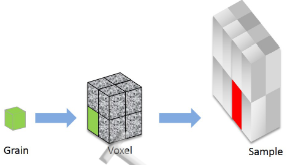Single crystal to polycrystal neutron transmission simulation
Abstract
A collection of routines for calculation of the total cross section that determines the attenuation of neutrons by crystalline solids is presented. The total cross section is calculated semi-empirically as a function of crystal structure, neutron energy, temperature, and crystal orientation. The semi-empirical formula includes the contribution of parasitic Bragg scattering to the total cross section using both the crystal’s mosaic spread value and its orientation with respect to the neutron beam direction as parameters. These routines allow users to enter a distribution of crystal orientations for calculation of total cross sections of user defined powder or pseudo powder distributions, which enables simulation of non-uniformities such as texture and strain. In conclusion, the spectra for neutron transmission simulations in the neutron thermal energy range (2 meV–100 meV) are presented for single crystal and polycrystal samples and compared to measurements.
- Authors:
-
- Univ. of Tennessee, Knoxville, TN (United States). Dept. of Physcis; Oak Ridge National Lab. (ORNL), Oak Ridge, TN (United States)
- Oak Ridge National Lab. (ORNL), Oak Ridge, TN (United States)
- Publication Date:
- Research Org.:
- Oak Ridge National Lab. (ORNL), Oak Ridge, TN (United States)
- Sponsoring Org.:
- USDOE Office of Energy Efficiency and Renewable Energy (EERE), Renewable Power Office. Geothermal Technologies Office
- OSTI Identifier:
- 1423074
- Grant/Contract Number:
- AC05-00OR22725
- Resource Type:
- Accepted Manuscript
- Journal Name:
- Review of Scientific Instruments
- Additional Journal Information:
- Journal Volume: 89; Journal Issue: 2; Journal ID: ISSN 0034-6748
- Publisher:
- American Institute of Physics (AIP)
- Country of Publication:
- United States
- Language:
- English
- Subject:
- 36 MATERIALS SCIENCE; Polycrystals; Particle beams; Crystal orientation; Crystal optics; Neutron physics
Citation Formats
Dessieux, Luc Lucius, Stoica, Alexandru Dan, and Bingham, Philip R. Single crystal to polycrystal neutron transmission simulation. United States: N. p., 2018.
Web. doi:10.1063/1.5002102.
Dessieux, Luc Lucius, Stoica, Alexandru Dan, & Bingham, Philip R. Single crystal to polycrystal neutron transmission simulation. United States. https://doi.org/10.1063/1.5002102
Dessieux, Luc Lucius, Stoica, Alexandru Dan, and Bingham, Philip R. Fri .
"Single crystal to polycrystal neutron transmission simulation". United States. https://doi.org/10.1063/1.5002102. https://www.osti.gov/servlets/purl/1423074.
@article{osti_1423074,
title = {Single crystal to polycrystal neutron transmission simulation},
author = {Dessieux, Luc Lucius and Stoica, Alexandru Dan and Bingham, Philip R.},
abstractNote = {A collection of routines for calculation of the total cross section that determines the attenuation of neutrons by crystalline solids is presented. The total cross section is calculated semi-empirically as a function of crystal structure, neutron energy, temperature, and crystal orientation. The semi-empirical formula includes the contribution of parasitic Bragg scattering to the total cross section using both the crystal’s mosaic spread value and its orientation with respect to the neutron beam direction as parameters. These routines allow users to enter a distribution of crystal orientations for calculation of total cross sections of user defined powder or pseudo powder distributions, which enables simulation of non-uniformities such as texture and strain. In conclusion, the spectra for neutron transmission simulations in the neutron thermal energy range (2 meV–100 meV) are presented for single crystal and polycrystal samples and compared to measurements.},
doi = {10.1063/1.5002102},
journal = {Review of Scientific Instruments},
number = 2,
volume = 89,
place = {United States},
year = {Fri Feb 02 00:00:00 EST 2018},
month = {Fri Feb 02 00:00:00 EST 2018}
}
Web of Science
Figures / Tables:
 FIG. 1: Each grain cross section is calculated, a distribution of grains is aggregated to form voxel cross-section , with voxel cross sections a sample can be simulated.
FIG. 1: Each grain cross section is calculated, a distribution of grains is aggregated to form voxel cross-section , with voxel cross sections a sample can be simulated.
Works referenced in this record:
Bragg Reflection of Slow Neutrons
journal, September 1936
- Mitchell, Dana P.; Powers, Philip N.
- Physical Review, Vol. 50, Issue 5
Full-pattern analysis of time-of-flight neutron transmission of mosaic crystals
journal, February 2016
- Malamud, Florencia; Santisteban, Javier R.
- Journal of Applied Crystallography, Vol. 49, Issue 2
Cross-sections of materials used as neutron monochromators and filters
journal, August 1983
- Freund, Andreas K.
- Nuclear Instruments and Methods in Physics Research, Vol. 213, Issue 2-3
Focusing neutron guides for VULCAN—Design aspects, estimated performance, and detector deployment
journal, February 2009
- Wang, X. -L.; Stoica, A. D.
- Nuclear Instruments and Methods in Physics Research Section A: Accelerators, Spectrometers, Detectors and Associated Equipment, Vol. 600, Issue 1
The effects of simultaneous reflections on single-crystal neutron diffraction intensities
journal, July 1964
- Moon, R. M.; Shull, C. G.
- Acta Crystallographica, Vol. 17, Issue 7
Approximate calculation of multiple-diffraction patterns based on Renninger's kinematical `simplest approach'
journal, June 2000
- Rossmanith, Elisabeth
- Journal of Applied Crystallography, Vol. 33, Issue 3
Characterization of Crystallographic Structures Using Bragg-Edge Neutron Imaging at the Spallation Neutron Source
journal, December 2017
- Song, Gian; Lin, Jiao; Bilheux, Jean
- Journal of Imaging, Vol. 3, Issue 4
First In Situ Lattice Strains Measurements Under Load at VULCAN
journal, October 2010
- An, Ke; Skorpenske, Harley D.; Stoica, Alexandru D.
- Metallurgical and Materials Transactions A, Vol. 42, Issue 1
Using pulsed neutron transmission for crystalline phase imaging and analysis
journal, April 2005
- Steuwer, A.; Withers, P. J.; Santisteban, J. R.
- Journal of Applied Physics, Vol. 97, Issue 7
The atomic simulation environment—a Python library for working with atoms
journal, June 2017
- Hjorth Larsen, Ask; Jørgen Mortensen, Jens; Blomqvist, Jakob
- Journal of Physics: Condensed Matter, Vol. 29, Issue 27
High-Resolution Strain Mapping Through Time-of-Flight Neutron Transmission Diffraction with a Microchannel Plate Neutron Counting Detector: High-Resolution Strain Mapping
journal, September 2011
- Tremsin, A. S.; McPhate, J. B.; Steuwer, A.
- Strain, Vol. 48, Issue 4
Diffraction in neutron imaging—A review
journal, January 2018
- Woracek, Robin; Santisteban, Javier; Fedrigo, Anna
- Nuclear Instruments and Methods in Physics Research Section A: Accelerators, Spectrometers, Detectors and Associated Equipment, Vol. 878
?Umweganregung?, eine bisher unbeachtete Wechselwirkungserscheinung bei Raumgitterinterferenzen
journal, March 1937
- Renninger, M.
- Zeitschrift f�r Physik, Vol. 106, Issue 3-4
The effect of experimental resolution on crystal reflectivity and secondary extinction in neutron diffraction
journal, March 1965
- Dietrich, O. W.; Als-Nielsen, J.
- Acta Crystallographica, Vol. 18, Issue 2
Diffraction-line shift caused by residual stress in polycrystal for all Laue groups in classical approximations
journal, February 2000
- Popa, N. C.
- Journal of Applied Crystallography, Vol. 33, Issue 1
The Passage of Neutrons Through Crystals and Polycrystals
journal, June 1941
- Halpern, O.; Hamermesh, M.; Johnson, M. H.
- Physical Review, Vol. 59, Issue 12
Algorithms for deriving crystallographic space-group information
journal, March 1999
- Grosse-Kunstleve, R. W.
- Acta Crystallographica Section A Foundations of Crystallography, Vol. 55, Issue 2
3D Mapping of Crystallographic Phase Distribution using Energy-Selective Neutron Tomography
journal, April 2014
- Woracek, Robin; Penumadu, Dayakar; Kardjilov, Nikolay
- Advanced Materials, Vol. 26, Issue 24
Neutron scattering lengths and cross sections
journal, January 1992
- Sears, Varley F.
- Neutron News, Vol. 3, Issue 3
Feasibility study of neutron strain tomography
journal, July 2009
- Abbey, Brian; Zhang, Shu Yan; Vorster, Wim. J. J.
- Procedia Engineering, Vol. 1, Issue 1
Bragg Reflection in Mosaic Crystals. I. General Solution of the Darwin Equations
journal, January 1997
- Sears, V. F.
- Acta Crystallographica Section A Foundations of Crystallography, Vol. 53, Issue 1
Secondary extinction and neutron crystallography
journal, December 1948
- Bacon, G. E.; Lowde, R. D.
- Acta Crystallographica, Vol. 1, Issue 6
Measurements of grain volume distribution parameters in polycrystals characterized by a log-normal distribution function
journal, March 1993
- Bucki, J. J.; Kurzydłowski, K. J.
- Scripta Metallurgica et Materialia, Vol. 28, Issue 6
Attenuation of thermal neutrons by an imperfect single crystal
journal, June 1996
- Naguib, K.; Adib, M.
- Journal of Physics D: Applied Physics, Vol. 29, Issue 6
Neutron characteristics of single-crystal magnesium fluoride
journal, October 2013
- Adib, M.; Habib, N.; Bashter, I.
- Annals of Nuclear Energy, Vol. 60
Inverse pole figure mapping of bulk crystalline grains in a polycrystalline steel plate by pulsed neutron Bragg-dip transmission imaging
journal, October 2017
- Sato, Hirotaka; Shiota, Yoshinori; Morooka, Satoshi
- Journal of Applied Crystallography, Vol. 50, Issue 6
New trends in neutron imaging
journal, June 2009
- Kardjilov, Nikolay; Hilger, André; Manke, Ingo
- Nuclear Instruments and Methods in Physics Research Section A: Accelerators, Spectrometers, Detectors and Associated Equipment, Vol. 605, Issue 1-2
Energy-selective neutron transmission imaging at a pulsed source
journal, August 2007
- Kockelmann, W.; Frei, G.; Lehmann, E. H.
- Nuclear Instruments and Methods in Physics Research Section A: Accelerators, Spectrometers, Detectors and Associated Equipment, Vol. 578, Issue 2
Time-of-flight neutron transmission of mosaic crystals
journal, November 2005
- Santisteban, Javier R.
- Journal of Applied Crystallography, Vol. 38, Issue 6
Extinction in time-of-flight neutron powder diffractometry
journal, May 1988
- Sabine, T. M.; Von Dreele, R. B.; Jørgensen, J. -E.
- Acta Crystallographica Section A Foundations of Crystallography, Vol. 44, Issue 3
Tuning the activities of cuprous oxide nanostructures via the oxide-metal interaction
journal, May 2020
- Huang, Wugen; Liu, Qingfei; Zhou, Zhiwen
- Nature Communications, Vol. 11, Issue 1
Works referencing / citing this record:
Distinct Recrystallization Pathways in a Cold-Rolled Al-2%Mg Alloy Evidenced by In-Situ Neutron Diffraction
journal, September 2018
- Stoica, Grigoreta; Dessieux, Luc; Stoica, Alexandru
- Quantum Beam Science, Vol. 2, Issue 3
Figures / Tables found in this record:

 Search WorldCat to find libraries that may hold this journal
Search WorldCat to find libraries that may hold this journal